The Historic Pubs of London
by Pearl Harris
The history of the Pub goes back to the Romans, who first
introduced Tabernae to England, where food, wine and ale
were sold.
After the departure of the Romans, Alehouses sprang up all over
the country. Ale is a potent brew of malted barley, similar to
beer but without the hops. With increasing industrial pollution
in England, water no longer was safe to drink, so ale became the
drink of necessity.
Inns were run by Monks to feed and house travelers. The Tabard,
one of London's most famous Inns, unfortunately no longer exists.
This inn was forever immortalized by Chaucer in The Canterbury
Tales, written between 1387 and 1400:
"In Southwerk at the Tabard as I lay
Redy to wenden on my pilgrimage
To Caunterbury with ful devout corage, ..."
(In Southwark at the Tabard as I lay
Ready to go on pilgrimage
To Canterbury with full devout courage...")
In the Elizabethan era, the tavern, which sold only
wine, was established. The tavern, in contrast to the alehouse, a
place for the working man, catered to a more elite clientele of
professionals. It became the fashionable place to be seen. The
Anchor and Ye Olde Cheshire Cheese are two examples of historic
London taverns still open today.
The advent of coach travel necessitated the establishment of
the coaching inn, which fed, watered and accommodated
passengers, coachmen and horses. The word "pub" was coined by the
Victorians for the popular Public House. Today the pub is an
English institution. This is the place to meet friends, enjoy a
good meal, relax or do business. It is also a place for families,
as recent changes in the law allow minors into pubs if
accompanied by adults. Some pubs also provide accommodation.
The George Inn
77 Borough High Street, Borough, London, SE1 1NH.
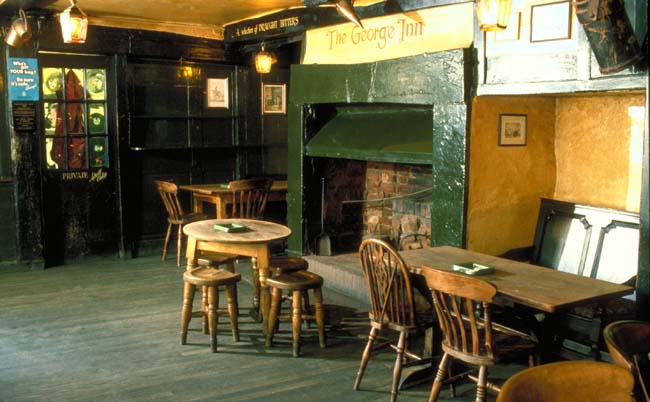
One of London's oldest pubs, situated in Southwark near London
Bridge, The George Inn is the city's only surviving galleried
coaching inn. It was rebuilt in 1676 after being damaged in a
destructive fire. The George Inn was fortunately saved from
demolition, unlike its historic counterpart, The Tabard, which
was demolished in the 19th century.
However, as rail travel superseded coach travel, a large portion
of The George Inn was knocked down by the Great Northern Railway
to create space for warehouses. Only the south face was left
intact and is now in the care of the National Trust.
The George Inn has several connecting bars on the ground floor.
The galleried section, which contained the accommodation for
travelers, is now the restaurant. The former Waiting Room for
coachmen and passengers is now The Old Bar. The Coffee Room,
frequented by Charles Dickens, is now The Middle Bar. On the wall
to the right of The Middle Bar, Dickens' life insurance policy is
displayed. Dickens mentions The George in Little Dorrit: "..if he
(Tip Dorrit) goes into the George and writes a letter..."
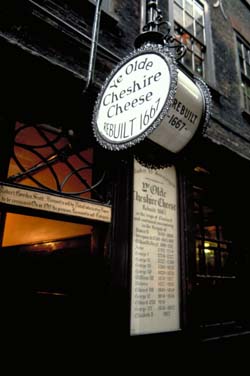
Ye Olde Cheshire Cheese
145 Fleet Street, City of London, EC4A 2BU.
"I've seen all of England, " she said. "I've seen Westminster
Abbey and the Houses of Parliament and His Majesty's Theatre and
the Savoy and the Cheshire Cheese...." (Piccadilly Jim-
P.G. Wodehouse)
The vaulted cellars of Ye Olde Cheshire Cheese are thought to
have been part of a 13th-century Carmelite Monastery. The former
inn on this site, dating back to 1538, was destroyed in the Great
Fire of 1666. Most of the pub was rebuilt in 1667.
At the entrance, a board records the reigns of the fifteen
monarchs through which Ye Olde Cheshire Cheese has endured.
Ye Olde Cheshire Cheese is exactly what one imagines an English
pub to be, with its warren of narrow passages and staircases
connecting the bars and dining rooms on various levels. Open
fireplaces, dark wooden beams and low ceilings add to the cozy
atmosphere.
Due to its location on Fleet Street, once home of the newspaper
trade, The Cheshire Cheese was the favorite watering hole of
journalists, in addition to a host of renowned literary and other
well-known personages, such as Charles Dickens, Voltaire, Samuel
Johnson, Oliver Goldsmith, Thackeray, Pope, Conan Doyle, Mark
Twain, WB Yeats, Oscar Wilde, Jack Dempsey, Teddy Roosevelt and
Polly.
The death of Polly, the parrot (now stuffed) in the ground floor
bar whose repute for mimicking customers for forty years was
legendary, was announced on BBC radio and in newspaper obituaries
around the world.
On display are the chair and dictionary of Dr. Samuel Johnson,
one of the pub's most illustrious past customers, whose house is
nearby. (See The London of Samuel Johnson.) His portrait
adorns the wall of The Chop Room, which is reserved for diners.
Fairly recently, a portrait of Johnson and Boswell, his
biographer, was discovered in a cellar.
John Galsworthy commented in The Forsyte Saga on the huge
pies once served here, which weighed up to 80 pounds, filled with
beef, kidneys, oysters, larks, mushrooms and spices. Delicious
pub grub is still served in this genuine London pub, well
deserving of its epithet, "Ye Olde".
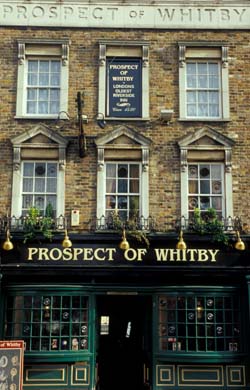 The Prospect of Whitby
57 Wapping Wall, Wapping, London,
E1W 3SJ.
The Prospect of Whitby, originally known as "The Devil's
Tavern," was built in 1543 and became notorious during the 17th
century as a smugglers' meeting place. Having being destroyed by
an 18th-century fire, it was rebuilt and renamed "The Prospect of
Whitby" after a ship of the same name that was anchored
nearby.
The pub interior is crammed with a fascinating array of ships'
relics, including lanterns, ropes and wheels. The dark wood
paneling, pewter-topped bar resting on barrels, parts of a ship's
mast forming the upright pillars, and flagstone floor all
contribute to the pub's unique décor.
It is a rare pleasure to sit out on the small balcony perched
above the Thames. Others might prefer the pleasant terrace, from
which superb views of the Isle of Dogs and the river may be
enjoyed. A rooftop terrace also overlooks the Thames.
The Prospect of Whitby must have been vastly different in past
centuries, with its unsavory clientele and surroundings, when the
River Thames was packed with countless foreign vessels. Today,
the occasional vessel cruises by, the surrounding warehouses have
been converted into exclusive apartments and the clientele is a
mix of tourists and locals. An up-market restaurant was opened
upstairs in the 1950s and has hosted royalty such as Princess
Margaret and Prince Rainier.
The Anchor
34 Park Street, Borough, London, SE1 9EF.
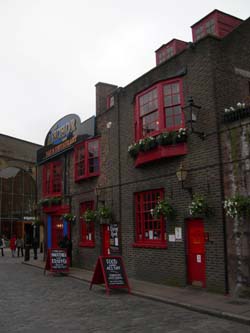 34 Park 34 Park
Dating from the 1600s, The Anchor, with a famous past
clientele, is situated in Bankside close to Shakespeare's Globe
Theatre and the Tate Modern Gallery. Extensive
modernization and enlargement of this ancient tavern resulted in
the creation of an additional large bar in the walled courtyard.
A Premier Hotel was constructed at the rear, somehow
overshadowing the original historic pub. The bars on the left,
however, are still well worth a visit.
It was from The Anchor that Samuel Pepys viewed the Great Fire of
London in 1666. He fled the intense heat of a boat on the river
to seek shelter in "a little alehouse on bankside ... and there
watched the fire grow". Dr. Johnson was another regular customer
to The Anchor, which has a copy of his dictionary on display.
In 1676, The Anchor was rebuilt after another devastating fire.
The entire pub's structure has been added to over the ages,
making it a fascinating hive of rooms containing several
congenial bars.
The Shakespeare Room is used for functions, while the main
dining room provides spectacular vistas over the river and city.
A riverside terrace and balcony are other pleasant venues.
More Historic London Pubs:
The Seven Stars, 53 Carey Street, Holborn, London. Built
in 1602, this is one of a handful of buildings in this area to
have survived the Great Fire of 1666. Situated as it is opposite
The Inns of Court and Royal Courts of Justice, The Seven Stars is
frequented by the legal profession.
Museum Tavern, 49 Great Russell Street, Bloomsbury,
London. Situated opposite the British Museum, on the site of an
18th-century pub, "The Dog and Duck". This popular pub changed
its name after the British Museum was built in the 1760s. It was
visited by Sir Arthur Conan Doyle, J.B. Priestley and Karl Marx.
Grapes, 76 Narrow Street, Limehouse, London. Built in
1720 on the site of a previous pub, this was a working class
tavern. It was frequented by Charles Dickens, who immortalized it
as the Six Jolly Fellowship Porters pub in Our Mutual Friend.
Trafalgar Tavern, Park Row, Greenwich. Built in 1837, this
is a magnificent example of a Regency-style pub. It used to be
the venue for Whitebait Suppers attended by Members of
Parliament. In 1915, the Trafalgar became a seamen's hostel and
later a working men's club. It was re-opened as a pub in
1965.
The Salisbury, at 90 St. Martin's Lane, Covent Garden,
London. Built as a restaurant, the "Salisbury Stores", in 1892
and later converted into a pub, its extravagant décor
includes art nouveau light fittings and cut glass mirrors. The
Salisbury is an outstanding example of a Victorian pub.
Ye Olde Mitre, on Ely Place off Chancery Lane, was
founded in 1546. It boasts a tree trunk in the front bar, which
is said to have been part of a maypole that Elizabeth I danced
around!
The Jerusalem Tavern in Britton Street EC1 was the pub of
choice of Handel and William Hogarth. This pub stocks some of
the best real ales in London.
The Star Tavern in Belgravia is surrounded by mews
cottages, which were originally stables. It is thought that The
Great Train Robbery was planned here.
The French House on Dean Street W1 was named after the
World War II Resistance fighters who met here.
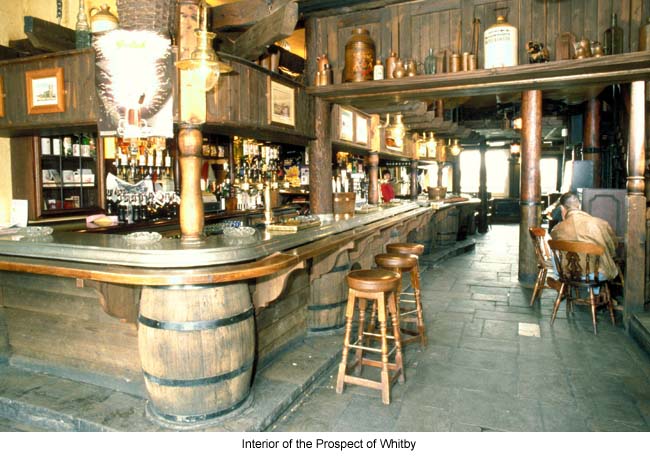
London pubs are brimful of history, many of their names
reflecting either an historic event or personage. What better
way indeed of being transported back through the annals of time
than by sipping a refreshing drink in a cozy pub haunted by the
ghosts of its past illustrious or notorious clientele?
Related Articles:
- A Beginner's Guide to British Pubs, by Graham Hughes
- https://www.timetravel-britain.com/articles/travel/pubs.shtml
- Haunted Pubs of England, by Dr. Gareth Evans
- https://www.timetravel-britain.com/articles/history/hauntedpubs.shtml
- A History of Britain in Its Pub Signs, by Elaine Saunders
- https://www.timetravel-britain.com/articles/history/pubsigns1.shtml
- The London of Samuel Johnson, by Sean McLachlan
- https://www.timetravel-britain.com/articles/london/johnson.shtml
More Information:
We regret that we no longer have the resources to maintain up-to-date links and/or hours and pricing details for the various sites and attractions listed on this website. For more information about the location(s) listed above, please use your favorite search engine or visit Wikipedia.
Pearl Harris, whose ancestors hail from Britain, was born in South Africa. In 2002, she emigrated to the Czech Republic with her husband, their dog and cat. Pearl resides permanently in the Czech Republic where she works as a freelance travel writer, English teacher and proof-reader. Her main passion is travel. Having traveled extensively in Africa, Europe,the USA and UK, she never intends to stop. Other interests are pets, photography, reading and writing. Pearl, a retired Diagnostic Radiographer, has a B.A. in English and Linguistics, post-graduate Diploma in Translation and TEFL qualification. Her only daughter, a professional photographer, lives in New Orleans.
Article © 2007 Pearl Harris
Anchor Pub © 2008 by Moira Allen; additional photos courtesy of VisitLondon.com and britainonview.com
|
